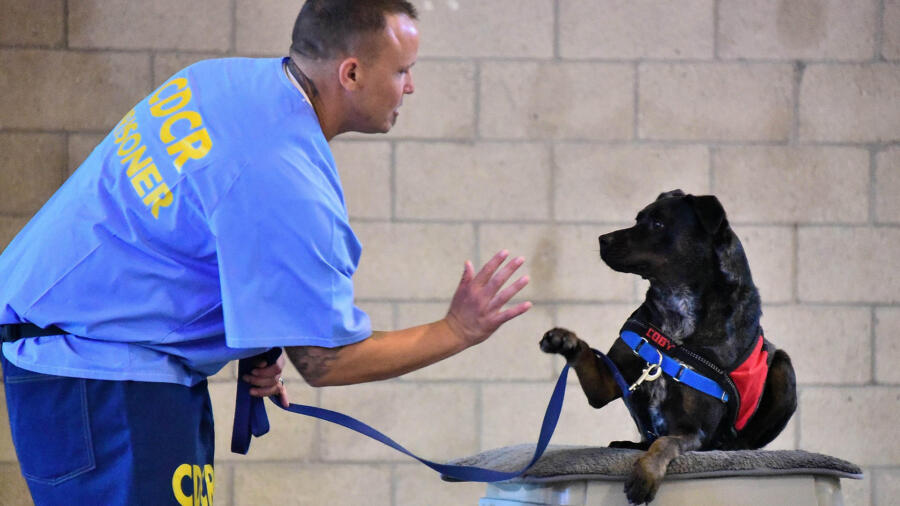More and more correctional facilities are putting dogs in prison. No, they are not being punished for their misdeeds; these canines are getting schooled to be service or assistance animals. They’re serving time—and so are the inmates who are teaching them to behave.
In-prison, animal-training programs are growing by leaps and bounds and have been shown to help keep released inmates from ending up back in prison. According to a study published in the Nevada Law Journal, the average national recidivism rate is 28 percent; but for those who participated in an animal-training program in a Washington State prison, it was only 5 percent.
At least 290 correctional facilities across the country have dog-training programs, and dogs aren’t the only creatures benefiting: There are programs caring for racehorses who can no longer race, taming wild mustangs, helping at-risk raccoons and other wildlife, and chilling out with abused cats considered otherwise unadoptable.
We talked to Deb Davis, community outreach manager for Paws With a Cause, a group that works with six Michigan Department of Corrections facilities to train service and assistance dogs.
What are the dogs being trained for?
We train assistance dogs. They help people with disabilities, complete tasks such as opening a door or picking things up. Some of our dogs alert the hearing-impaired, others are seizure-response dogs and some pair up with children with autism.
Where do you get the dogs and what breed are they?
We have our own breeding program that has been around 37 years. For the first 15 years, we rescued dogs from animal shelters and trained them. But then the breed rescue programs would beat us to the shelters because they had more volunteers. So, we started our breeding program.
The dogs are usually golden retrievers, Labrador retrievers, and 50-50 mixes of the two. Sometimes, if clients need hypo-allergenic dogs, we’ll train poodles or poodle mixes. Some of the hearing dogs are small breeds.
How are the dogs trained?
Each dog is raised by a volunteer family until it is 12 months old. The family teaches the dog basic obedience (sit, stay, lie down).
Next, the dogs go into the prison program for four months for Phase 1 training. It’s a maturity thing—when dogs reach about 12 to 14 months, they turn into teenagers, meaning they know everything, but they know nothing. It’s very exasperating for the volunteers to raise these dogs and then have the dog turn around and say, “What is this ‘sit’ you are talking about?” The inmates have lots of time for training and trouble-shooting problem behaviors.
After four months, we say we “bust them out of prison.” We bring the dogs back to our training center and build on the training the inmates have done. The specialized-assistance training can take four to six months more. We have a waiting list of over 200 people with disabilities who need dogs, so there’s a great need to raise and train more puppies. We go into prison and train the inmates, and then our outside volunteers have the time to focus on other aspects of raising the dogs.
It must be important to know your dogs won’t turn around and bite people.
Therein lies the importance of our breeding program. We have to know at least two generations back to produce a litter with the qualities and traits we need. We pick goldens and labs because of their intelligence and their retrieving talent. (They are in the sporting group.) We need [them to have] a good temperament and an excellent medical background. These dogs live an average of 10 to 12 years with their person. We need evidence that there’s no hip dysplasia, for example, because the dog may be getting up on its back legs to turn on a light. We want to give the person as long a period as we can with their dog.
Why are these programs important?
We place our service dogs at no cost. Our clients pay nothing, so the free labor we get from the inmates in the prison makes a big difference. [Participating inmates do get a small wage paid from prison funds. PAWS needs to raise $30,000 to cover the breeding, training and continued support for each client’s dog.]
Who decides which inmates get to work with the dogs?
The prison officials accept applications from inmates (who must have at least four years left in their sentence) and screen them. The trainers can’t have a history of violence or criminal-sexual conduct. Any inmate infraction in the last year makes them ineligible. And, if an infraction occurs while they’re acting as a PAWS Prison Partner, they are permanently expelled from the program.
Do the dogs live with the inmates?
The dogs are with the inmates for four months, 24/7, and sleep in their cells. We work with the prison to find a cell block where an area could be devoted just to the dog-training program, because the dogs aren’t going into the general population. The officials then move the chosen inmates down to the dog floor. The dogs don’t go to meals or general-population exercise time, though. They have crates in their trainers’ cells and separate exercise time and areas.
How has your organization found the collaborations so far?
The collaboration has been extremely positive for us. When you are talking about living, breathing dogs, finding things for their brains to do can be something of a challenge. We get inmates who can focus their time on teaching obedience and skills. Prison officials tell us there are positive effects on inmates and employees. And we get a much more confident dog ready to come back here to learn. The inmates’ work can shave months off formal-assistance dog training. After the months with inmates, our trainers find they can attain a higher level of training.
What else do the prisons get out of the dog training?
They absolutely love the program. It’s teaching these inmates some empathy. People are not in prison, usually, because [they have] done nice things. They’ve probably made wrong choices. By introducing these inmates to the dog program, it’s not only having an effect on the inmate handlers, but also the [prison’s] general population and the staff. Prison officials say they see a more empathetic inmate, a more relaxed environment and fewer infractions—less tickets (that’s what inmates get for infractions). They’re seeing a more relaxed atmosphere all around.
What do the inmates get out of it?
They are learning how to take care of something other than themselves, putting the dogs first. It’s not just feeding and walking them. The inmates have to think about the safety of a situation they’re taking their dog into. For example, the handler looks to see if there’s anything on the ground that could hurt their dog’s feet. They make sure the dogs are not walking across ice—because we are in Michigan and we get a lot of winter. That whole mentality of thinking outside themselves is one benefit to the prison. The program also helps the inmates develop interpersonal skills and learn how to communicate—you can’t talk to your dog with a rough voice. These are all interpersonal skills and dynamics that will help them in the future.
Is it hard for the inmates to say goodbye to the dogs when training is done?
Turn-in day, which is what we call it when the inmates give back their dogs, is bittersweet. But we’ve had such great success and found that inmates in this program commit almost no infractions, so this allows them to stay in the program. So, it’s really turnover day—they get placed with another dog that same day.


